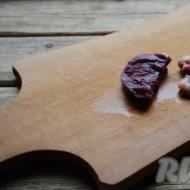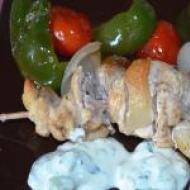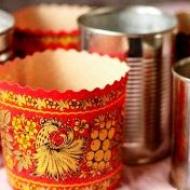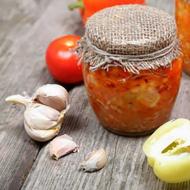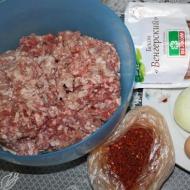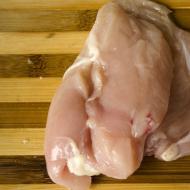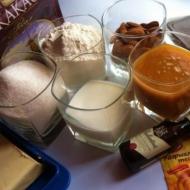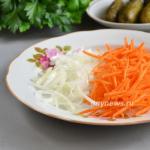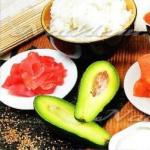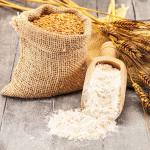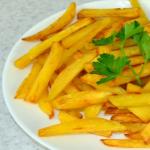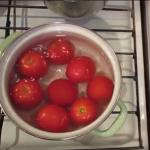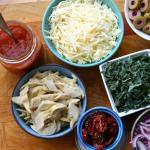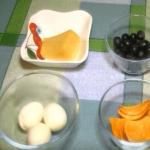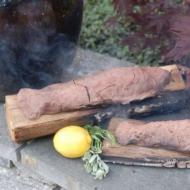
Recipe for liquid Easter in the oven. Easter cake recipe in the oven. Cooking cottage cheese cake
Many housewives believe that preparing delicious Easter on their own is unrealistic for a person without experience, but this is far from the case. That year I already shared my first impressions of baking with readers of the Poradka website :). As it turned out, it’s nothing complicated - the eyes are afraid, but the hands do it.
Every family keeps several recipes for making delicious Easter at home. Our family is no exception. Here are a few recipes for making delicious homemade paskas and Easter cakes that have been tested over the years.
To begin with, I suggest you familiarize yourself with a few useful tips and secrets for preparing delicious Easter baked goods: pasok and Easter cakes. You can read how to color Easter eggs in all the colors of the rainbow using natural dyes.
Preparing the mold for paskas:
 It is better to bake Easter in a tin pan. Be sure to line the bottom of the pan with oiled paper. To do this, cut a circle out of parchment, slightly larger than the diameter of the bottom of the Easter pan, grease it on both sides with a piece of butter, thoroughly grease the sides and bottom of the pan, carefully place the parchment on the bottom of the pan and straighten its edges.
It is better to bake Easter in a tin pan. Be sure to line the bottom of the pan with oiled paper. To do this, cut a circle out of parchment, slightly larger than the diameter of the bottom of the Easter pan, grease it on both sides with a piece of butter, thoroughly grease the sides and bottom of the pan, carefully place the parchment on the bottom of the pan and straighten its edges.
Place the prepared pans in a warm place and cover with a clean towel.Now there is an alternative to cans - paper forms.
Preparing raisins (candied fruits) for Easter cake:

Wash the raisins thoroughly in running water.
Pour boiling water over the raisins and after fifteen minutes drain the water and place in a colander.Place the raisins on a clean waffle towel and dry.
In order for the raisins to be evenly distributed in Easter cakes and Easter cakes, you need to roll clean, prepared raisins in flour.
Baking time for Easter cakes and Easter cakes:
At the same temperature, the weight of the cake is baked:
- from 300 gr. up to 1 kg – 15-30 minutes
- 1 kg – 45 minutes
- 1.5 kg – 1 hour
- 2 kg – 1.5 hours
Do not bake cakes that are too small, as they will quickly dry out and lose their taste and aroma.
Test location:
The Easter cake dough should be proofed in a warm room (ideally the temperature should be 250) where there are no drafts. You cannot place the dough where the heat comes from below (radiator, etc.), because the dough will spread during baking.Frosting for Easter:
- Beat two egg whites into a strong foam, gradually add powdered sugar one tablespoon at a time (just one glass). At the end of whisking, add a tablespoon of freshly squeezed lemon juice. The glaze should be applied on a warm Easter day. Decorate the top of the Easter with colorful sugar.
- Melt the white chocolate bar in a water bath. Grease the top of the Easter cake. Although such glaze will not be dazzlingly white, it will be very tasty.
Homemade Easter recipe
Products:
- 3 cups flour
- 1 glass of milk
- 50 gr. yeast
- 1 egg
- 5 yolks
- 100 gr. butter
- 1 cup of sugar
- vanillin
- candied fruit
Mash the yolks thoroughly, mix with 2/3 cup of milk, add flour, mix thoroughly, add yeast diluted in 1/3 cup of warm milk, mix again. Let the dough rise. Then add the egg, melted warm butter, sugar, salt, candied fruits, vanillin, knead thoroughly, let rise.
Grease the mold with oil and fill 1/3 full with dough. When it fits in the mold, put it in the oven. Bake over medium heat for about 15 minutes.
Easter recipe with raisins
Products:- 4 cups flour
- 2 glasses of milk
- 100 gr. yeast
- 1 egg
- 10 yolks
- 200 gr. butter
- 1 cup of sugar
- vanillin
- 1 cup raisins
Dissolve the yeast in half a glass of warm milk with 1 tablespoon of sugar and two tablespoons of flour. Grind the yolks with sugar, add warm milk, salt, flour, raisins (previously steamed with boiling water), lemon zest. Mix the dough well.
When the dough has risen, add melted butter, mix thoroughly again, put the dough in a warm place, and let rise. Grease the mold with oil and fill 1/3 full with dough. When it fits in the mold, brush the top of the Easter eggs with yolk and place in the oven. Bake over medium heat for about 15 minutes.
Homemade Easter cake recipe
Products:- 1 kg flour
- 1.5 cups milk
- 50 gr. yeast
- 7 eggs
- 300 gr. butter
- 1.5-2 cups sugar
- ¾ teaspoon salt
- vanillin
- 50 gr. candied fruits
- 50 gr. almonds
- 150 gr. raisins
Dissolve yeast in 1.5 cups of warm milk, add 0.5 cup of flour, stir so that there are no lumps, cover and place in a warm place to rise. When the volume of the dough has doubled, add salt, 6 yolks, mashed with sugar and vanilla, and butter. Mix everything thoroughly. Beat the egg whites with a mixer until fluffy and add to the dough. Pour in the remaining half a kilogram of flour. The dough should not be very thick, elastic and should lag well behind your hands and the walls of the dish.
Cover the dough and place in a warm place to rise. When it comes up and doubles in size, add steamed raisins, candied fruits, almonds, grated on a fine grater. Grease the mold with oil and fill 1/3 full with dough. When it fits in the mold, brush the top of the Easter cakes with yolk and place in the oven.
Custard Easter cake recipe
Products:- 1 kg flour
- 1.5 cups milk
- 50 gr. yeast
- 10 yolks
- 3 squirrels
- 200 gr. butter
- 250 gr. Sahara
- 1 gr. salt
- vanillin, nutmeg, lemon zest - to taste
- 25 gr. candied fruits
- 50 gr. almonds
- 100 gr. Raisins
- 25 gr. cognac
Place the dough: pBrew 100 grams with half a glass of boiling milk. flour, stirring quickly with a wooden spoon until an elastic mass is obtained.
Dilute the yeast with 0.5 cups of warm milk and mix with 100 g. flour, leaving for a few minutes.
Combine both mixtures, cover with a towel and place the dough in a warm place for an hour and a half.
Now let's fill:Grind the Christmas trees, sugar, a pinch of salt until white. Pour half of the filling into the risen dough, add 250 g. Flour and knead well. Let the dough rise for another hour.
Then pour the second part of the filling into the risen dough, add 500 g. flour, and knead the dough until the dough does not stick to your hands. The dough is ready.
Gradually pour warm melted butter into it and knead well.
Add spices and cognac. Grease the mold with oil and fill 1/3 full with dough. When it fits in the mold, brush the top of the Easter cakes with yolk and place in the oven.
Cottage cheese Easter recipe
Products:- 2 kg cottage cheese
- 400 gr. butter
- 800 gr. sour cream
- 4-5 cups granulated sugar
- 5 eggs
- 1 cup raisins
- 200 gr. nuts
Preparation:
Grind the cottage cheese, add a little powdered sugar, then butter and sour cream. Grind the main part of the sugar with the eggs, separately with the yolks until white. Add the sugar-egg mixture to the butter-curd mixture and grind together. Then add the spices mixed in half with powdered sugar. Easter is then topped with whipped cream or whipped egg whites, or sometimes both. Lastly, add candied fruits, raisins, nuts and mix carefully. Place Easter under pressure in a cool place.
As you can see - nothing complicated! Choose your favorite homemade Easter cake and Easter cake recipe and cook with pleasure! Happy Sunday!
Instructions
- The Easter recipe in the oven, of course, involves preparing dough. Pour 2 tablespoons of dry yeast into a bowl and pour in warm milk. Pour in the milk gradually in small portions. In total, you will need one and a half glasses of milk. Stir thoroughly until a homogeneous mixture is obtained.
- Add 500 g of flour to the milk mixture. Also add flour in small portions. Mix well first with a spoon and then with your hand. Stir until lumps disappear. Cover the container with cling film and a towel on top and place in a warm, draft-free place for two hours. The dough will double in volume.

- Break the eggs into a bowl, separating the yolks from the whites. Drain the whites into a mixer bowl and knead until a white homogeneous mass is obtained. You should get a strong foam. The dough for Easter cake (recipe in the oven) turns out very tender precisely because the whites and yolks are whipped and introduced into the dough separately.

- In a separate container in a food processor or using a mixer, grind the yolks with sugar - 400 g. Add three-quarters of a teaspoon of salt, six crushed cardamom grains or two bags of vanilla sugar.

- Place the risen dough into a large bowl. Add mashed yolks. Mix the dough well with your hands.

- Add 300 g of softened butter. Mix the dough very well with your hand, then add the whipped whites. Now you can stir with a spoon until a homogeneous mixture is obtained.

- Sift the remaining 500 g of flour into the dough. Stir first with a spoon, and then carefully sweep out the cake dough. Knead until the dough begins to easily pull away from the sides of the bowl.

- Cover the finished dough with film and a towel. Place in a warm place for two hours.

- While the dough is rising, peel the almonds. To do this, lower it into boiling water. After a minute, drain the water and transfer the almonds to a plate. Now it is easy to peel it. Be sure to rinse the peeled almonds with cold water to prevent them from darkening. Pat dry with paper towel and place on a baking sheet. Place in the preheated oven for a few minutes.

- The recipe for Easter with raisins in the oven assumes that in addition to the raisins themselves, you can add other ingredients to it. So, add 150 g of washed and dried raisins, 100 g of chopped almonds, 50 g of chopped candied fruits to the suitable dough. Mix thoroughly.

- Grease the cake pans generously with butter. Large tin cans can be used as molds. Fill them one-third full. Cover with film and a towel and place in a warm place.

- When the dough in the pans has risen to two-thirds of its height, carefully brush the tops of the cakes with yolk. Bake Easter cakes at 180 degrees for 30 to 60 minutes. Check readiness with a wooden stick.

- Prepare the glaze to decorate the cakes. Place one egg white in a bowl, add 100 g of powdered sugar and half a tablespoon of lemon juice. Grind using a mixer. Decorate the finished Easter cakes. You can sprinkle confectionery sweets on top. Now you have at your disposal a simple and delicious Easter recipe in the oven. Happy holiday of the Holy Resurrection of Christ!

Calories: Not specified
Cooking time: Not indicated
We have many positive, kind and warm traditions in our family. One of them is the joint baking of Easter cakes on the eve of the Orthodox Easter holiday. We have a large family, so we make at least a dozen beads. After a long abstinence from meat, dairy products, baked goods, and usual sweets, we prepare this sweet culinary product with special enthusiasm. Often, we used a recipe for baking Easter cakes from an old family book. That year, it was decided to try a completely new and unusual dough for these culinary products - yeast dough with water. The great taste of the paskas exceeded my expectations! Now I recommend it to everyone: make Easter cakes according to this step-by-step recipe, then your sweet masterpiece will become the center of the festive Easter table. Be sure to save this simple and delicious Easter recipe in the oven to your culinary treasure chest. Check out others too.
Ingredients:
- 1 chicken egg,
- ½ glass of warm boiled water (no more than 40 degrees),
- 30 grams of granulated sugar,
- 225 grams of wheat flour,
- 25 milliliters of refined vegetable oil,
- ½ teaspoon dry yeast,
- half a pinch of table salt.
How to cook with photos step by step
First of all, start preparing the dough: pour warm water into any convenient container, add dry yeast, sugar and salt, leave the dough for 25-30 minutes so that the yeast “plays.” 
In another bowl, beat the egg with a fork and add it to the yeast when it starts to bubble. 
Then add vegetable oil and sifted flour (if you do not sift it, then any baked goods will not turn out airy), knead the dough and let it rise. Leave the dough to rise in a place without drafts and always warm. 

In special molds for baking paskas (paper or metal, the latter need to be greased with oil), place 1/3 of the prepared dough. After the dough in the molds has risen and filled them 2/3, send the paskas to the oven, evenly preheated to 190 degrees, bake until ready. This one is very easy to prepare too. 
Check the readiness of the cakes with a wooden skewer by carefully piercing the dough with it: if you take out a dry skewer, then consider that the baked goods are ready. Remove the paskas from the oven, cool and cover the tops with white glaze. Making the glaze is very simple. To do this, beat the powdered sugar with the white of one chicken egg with a mixer until it has a homogeneous, airy consistency. Sprinkle the icing on the cakes with nonpareil or gold edible beads, or decorate with fondant flowers. 
Easter cakes get a place of honor on the Easter table. On this day it is not customary to serve other sweets. A real cake should be light and porous. The dough is generously flavored with raisins. The meal begins with the blessed Easter cake; its taste should remain in memory until next year. We invite you to prepare a delicious Easter meal. This recipe presents the classic technology for making Easter dough; friends and relatives will definitely appreciate your efforts.
TIME: 3 hours 30 minutes.
Average
Servings: 8-10
Ingredients
- flour – 2 kg,
- yeast – 100 g,
- butter – 300 g,
- sugar – 600 grams,
- milk – 500 ml,
- eggs – 10 pcs.,
- vanilla sugar – 1 tsp,
- raisins – 150 grams.

Preparation
The milk is heated, two tablespoons of sugar and six tablespoons of flour are dissolved in it. Add crushed yeast. The baked goods will be tender and porous if the yeast is fresh. The yeast bar should break easily. A sign of “old age” of the product is yeast “stretching” at the break. 
The yeast is stirred, although complete dissolution is not necessary. After some time they will “disperse” themselves. Cover the bowl with a towel. 
After just 15 minutes, the dough will increase several times in size. Wait another 5-10 minutes. As soon as the dough “grows” to the edges of the bowl, the batter is poured into a large saucepan. Look at the photo, this is what the dough for Easter should look like. 
The butter needs to be melted, but not brought to a boil. The cooled melted butter is poured into the dough. 
Add eggs to a bowl with sugar. Seven pieces are thrown in whole, and only the yolks are separated from three eggs. Three egg whites are poured into a clean bowl and placed in the refrigerator; they will be useful for Easter icing. Beat the eggs with sugar for 2-3 minutes, then pour the liquid into the dough.
Sift the flour, gradually mix it into the dough, adding one glass at a time. The kneading process lasts about 15 minutes. You can grease your hands with sunflower oil, then the dough will not stick to your palms. The finished dough should not be tight.

For Easter cakes, market eggs are usually used to get a bright, warm color of the dough. Cover tightly with a towel and leave for an hour. The butter dough is infused in absolute silence. Even the sound of dishes and slamming doors can “scare” the dough, and it will collapse.
After an hour, the dough is kneaded. The washed and dried raisins are sprinkled with a handful of flour so that they are evenly distributed in the dough. Place raisins in the dough and stir. Cover the pan again with a towel and leave for an hour and a half.

The next step is to grease the baking dishes with sunflower oil and fill them one-third with dough. Cover the molds with a towel. Place them in the oven when the dough has risen and filled two-thirds of the pan. As a rule, this happens after half an hour.

The oven is heated to 180 degrees. They celebrate Easter. Baking time – 40 minutes.
While the cakes are cooling, you can make the glaze. Beat the cooled egg whites, gradually adding one and a half cups of sugar or powdered sugar.
Easter is coated with sugar icing and sprinkled with colored decorations.

Easter baking is special. It is so aromatic, tender and tasty that it is difficult to compare it with the usual buns, muffins, bread, etc. It smells unusually of vanilla and zest. Even when the dough is on the table, there is already a festive atmosphere in the kitchen, something bright and incredibly magical. The main rule when working with Easter baking is a good mood, bright, kind thoughts and a positive attitude.
Before baking Easter in the oven, you need to prepare all the ingredients. They should be the same, room temperature.

Prepare the dough: add 2 tsp to the milk. sugar, add dry yeast and 3 tsp. flour. Stir, cover with a towel and leave in a warm place. If the room is not warm enough, you can heat water in a saucepan and place the bowl with the dough on top of it (only so that the bowl with the dough does not come into contact with the water). If the yeast is fresh and of good quality, it will take 15-20 minutes to activate it. And if not, it’s better not to start baking.

To prepare the dough you will need 5 yolks and 3 whites. Separate the yolks from the whites. This must be done carefully so that the yolk does not get into the whites, otherwise it will not be possible to beat them into a fluffy mass. If white gets into the yolks, it’s okay.

Add salt, vanilla sugar, regular sugar to the yolks and add softened butter.

Using a mixer, beat everything into a homogeneous mass.

When the dough is ready, pour in the egg-butter mixture. Mix everything thoroughly.

Separate 3 egg whites into a mixer bowl and beat until fluffy, pour into the dough.

Mix everything thoroughly again and begin adding the twice-sifted flour in parts. During sifting, the flour is enriched with oxygen, and the baked goods are more fluffy.

Wash the orange thoroughly, pour boiling water over it and remove the zest.

Add it to the dough, mix and continue adding flour in parts. It must be added in small portions and mixed thoroughly, slowly, each time. Let every movement while preparing the dough bring you pleasure. When the dough is thick enough, place it on the work surface and continue kneading slowly. If the dough sticks to the table, you need to shake it with a small amount of flour. Knead the dough for 15-20 minutes.

Steam raisins and dried apricots, after 5 minutes place on a towel, removing excess moisture. Cut dried apricots into small pieces.

Make a small depression in the center of the dough and place raisins and dried apricots.

And mix the dough well again. Place it in a deep bowl and place in a warm place until it doubles in volume.

When the dough has “ripened”, mix it again and divide it into parts according to the number of shapes.

If the molds are metal or glass, they must be greased with oil and the bottoms lined with baking paper - this will make it easier to remove the finished baked goods. If the shapes are the same size and you want to get the same beautiful Easter eggs, use a scale when laying the dough.
Cover the molds with a towel to prevent the dough from airing on top, and leave in a warm place for 15-20 minutes.

Place the molds in an oven preheated to 180 degrees and bake for 45-55 minutes.

Baking Easter in the oven is complete. After that, remove it from the oven and decorate with egg white glaze. To prepare it you will need the following ingredients: egg (white), sugar and citric acid.

Beat the whites with a mixer until fluffy foam. Add citric acid and immediately add sugar. Beat until thick. This glaze will look good on finished baked goods and will not stick to your hands after an hour or two.

Decorate Easter with egg white glaze. Top with confectionery sprinkles and decorate with sugar decorations, which will certainly amuse little guests.

Now the Easter baking is ready.

It is incredibly aromatic, tender, tasty and magical. Happy Easter!

Bon appetit. Cook with love.


